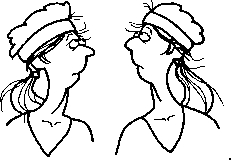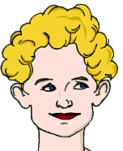You have already learnt some adjectives in lesson 25 that describe how people look:-
| beautiful |
handsome (men only) |
pretty (girls only) |
good looking |
ugly (men and women) |
|---|---|---|---|---|
| attractive |
||||
Adjectives for personality (people) or characteristics (places and things) |
||||||||||||
|---|---|---|---|---|---|---|---|---|---|---|---|---|
| lovely |
nice |
|
OK |
all right |
horrible |
terrible |
awful |
|||||
| For people | Question | Answer |
|---|---|---|
| Appearance | What does David look like? | Oh, he's a handsome man. He's tall with fair hair. |
| Personality | What is he like? |
He's a lovely man. |
| For places | Question | Answer |
|---|---|---|
| Appearance | What is Tuscany like? (What's Tuscany like?) |
Oh, it's a very pretty place. |
| Characteristics | What is Tuscany like? (What's Tuscany like?) |
It's a lovely place. |
| For things | Question | Answer |
|---|---|---|
| Appearance | What is the new Jaguar car like? (What's the new Jaguar car like?) |
Oh, it's a beautiful car. |
| Characteristics | What is the new Jaguar car like? (What's the new Jaguar car like?) |
It's a very comfortable car. |
Learning the opposite meaning of words can help you to quickly increase your vocabulary. |
|||
|---|---|---|---|
 |
big / large "It's a large animal." |
small "It's a small animal." |
|
 |
clean "She's a clean little girl." |
 |
dirty "She's a dirty little girl." |
 |
friendly "They're friendly people." |
 |
unfriendly "They're unfriendly people." |
 |
expensive "It's an expensive car." |
 |
cheap "It's a cheap car." |
 |
good "He's a good boy." |
 |
bad "He's a bad boy." |
| tall "He's a tall man." |
short "He's a short man." |
||
 |
long "She has long hair." |
 |
short "She has short hair." |
 |
comfortable "It's a comfortable chair." |
 |
uncomfortable "They're uncomfortable chairs." |
| happy "It's a happy face." |
sad "It's a sad face." |
||
 |
new "It's a new car." |
 |
old "It's an old car." |
|
when to use a or an, this is changed by the adjective. You use a when the noun you are referring to or the adjective that describes it begins with a consonant. You use an when the noun you are referring to or the adjective that describes it begins with a vowel. For example: It's a car. |

Follow the dialogue.
Mr Bean meets Mr Breuer again at a party.
| Mr Bean: | Hello, Mr Breuer. It's nice to see your again. |
| Mr Breuer: | Mr Bean, what a nice surprise! How are you? |
| Mr Bean: | I'm fine thanks, and how is Mrs Breuer? |
| Mr Breuer: | She's OK thank you. She's getting a new teacher next week, a Miss Burton. What's she like? |
| Mr Bean: | Don't worry she's very nice. She's really friendly. |
| Mr Breuer: | Oh that's good to know. You come from Derby, don't you Mr Bean? |
| Mr Bean: | Yes, that's right. |
| Mr Breuer: | What's it like? |
| Mr Bean: | It's a big city in the Midlands. It's a really nice city to live in, and the people there are very friendly. What's Dresden like? |
| Mr Breuer: | Dresden is a very large city in the East of Germany. It's beautiful in parts but quite ugly in others. There have been a lot of changes recently. |
| Mr Bean: | Yes, I can imagine. |